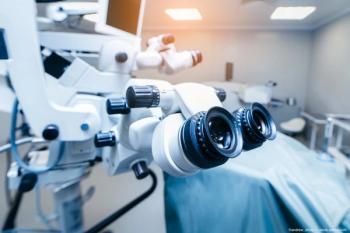
Laser channel dissection surpasses mechanical approach
Las Vegas-The use of a femtosecond laser (IntraLase, Advanced Medical Optics) to create channels for placement of corneal implants (Intacs, Addition Technology Inc.) seems to provide better visual and refractive improvements compared with mechanical implantation of the segments, according to Aylin Ertan, MD.
Las Vegas-The use of a femtosecond laser (IntraLase, Advanced Medical Optics) to create channels for placement of corneal implants (Intacs, Addition Technology Inc.) seems to provide better visual and refractive improvements compared with mechanical implantation of the segments, according to Aylin Ertan, MD.
"The femtosecond laser can be used in refractive surgery to create corneal flaps during LASIK, for anterior corneal transplantation, and to create corneal channels to implant [the inlays]. The creation of intrastromal corneal channels for [inlay] insertion has become a topic of interest since [the inlays] were first introduced," Dr. Ertan said at the American Academy of Ophthalmology annual meeting.
The femtosecond laser creates the channels by photodisruption and is an alternative method to the conventional mechanical technique. Dr. Ertan is head, cataract and refractive surgery department, Kudret Eye Hospital, Ankara, Turkey.
One hundred eyes were treated with the mechanical procedure and 105 eyes with the femtosecond laser procedure. BCVA was the only measured parameter that was better preoperatively in the femtosecond laser group. The other parameters were similar in both groups preoperatively.
"The improvements in the UCVA and BCVA levels were significantly (p <0.05) higher in the patients treated with the femtosecond laser. When we compared the refractive and the topographic changes after [inlay] implantation, the improvement in the spherical equivalent was significantly (p <0.05) greater in the femtosecond laser group. The mean keratometric values were similar in both groups. The visual and refractive improvement was better in the femtosecond laser group," Dr. Ertan reported.
A few advantages are associated with the laser when creating channels for the corneal implants, she said. "These include precise tunnel depth, width, and location; precise keratotomy depth, width, and location; easier surgery in deep-set eyes; and no foreign element is introduced into the corneal stroma," she said. "There is a low risk of infectious keratitis, minimal risk of epithelial defects and stromal edema, no need for suture placement, no channel haze or edema, and the procedure is completed within seconds with no corneal manipulation."
The disadvantages of the femtosecond laser, Dr. Ertan said, include the development of fibrosis, inadequate separation of corneal tissue, a maximum channel depth of 400 μm, and increased cost.
The limitations of the study were that patients were treated at two centers, with different nomograms, channel sizes, and measurement devices, she said.
Newsletter
Don’t miss out—get Ophthalmology Times updates on the latest clinical advancements and expert interviews, straight to your inbox.


















































.png)


